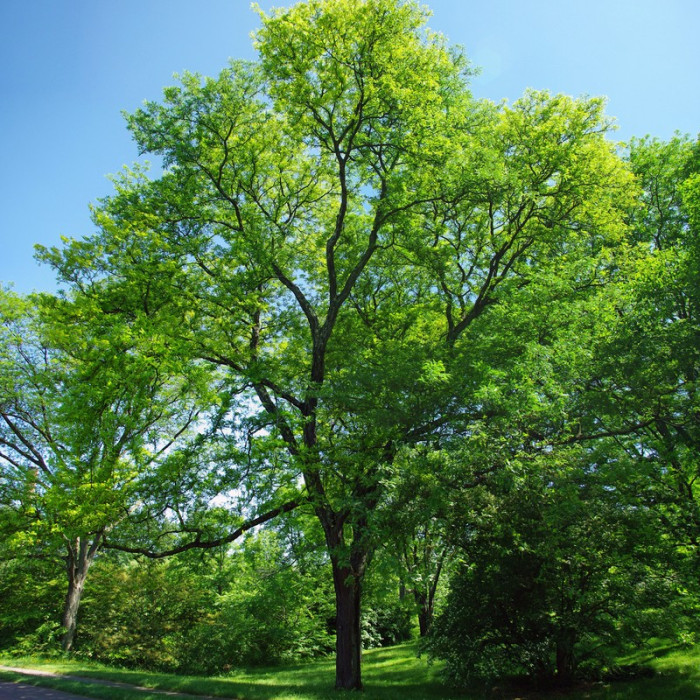Honey locust / Gleditsia triacanthos
A species of trees from the genus Gledichia of the legume family. A powerful tree up to 20-40 m high, with a beautiful, openwork, sprawling, broadly cylindrical, rounded crown at the top. The trunk is up to 75 cm in diameter, dark brown, with wrinkled, later cracking bark. Lives up to 300 years.
The root system is powerful, highly branched. In addition to deep roots, Gleditsia has powerful superficial roots that diverge far to the sides. Buds alternate, very small, red-brown, shiny. Leaf scar with three traces of vascular-fibrous bundles and almost covers the kidney.
Shoots are articulated, thickened under the buds, red-brown, smooth, shiny, with reddish longitudinal lenticels, occasionally have tripartite spines. The branches are slightly flat, gray or brown-green, with spines located above the buds. Spines are long, simple or thrice-branched, reddish-brown, glossy, sharp, flattened at least at the base, up to 20-30 cm long, according to other sources up to 6-10(15) cm. Shoots and branches are very brittle. The core is serrated.
Leaves are alternate, almost sessile, 14-20 cm long or more, paired with 8-15(17) pairs of leaflets or double-paired with 8-14 pairs of branches on the main grooved and pubescent leaf stem, on shortened shoots, collected in bunches. Leaflets in the first case 4.5-5 cm long, according to other sources up to 3.5 cm, according to the third - up to 3 (4) cm; in the second - smaller, up to 2 cm, according to other sources 0.8-1.5 cm; dark green, shiny, ellipsoid or lanceolate, narrowed towards the apex, entire or indistinctly crenate along the edges, slightly pubescent along the veins below. They bloom in April.
Flowers inconspicuous, greenish, pubescent, fragrant, in dense axillary narrow-cylindrical racemes up to 8 cm long, according to other sources 5-7 cm long, unisexual, occasionally bisexual. Sometimes on one tree there are only flowers of one sex. Calyx with 3-5 narrow lobes; corolla with 3-5 larger free, almost identical petals. Sepals and petals are pubescent. Stamens 6-10, free. Filaments pubescent; green anthers. Pistil with upper, slightly curved, sessile, hairy ovary, short style and wide mushroom-shaped stigma. Blooms in May-July.
Fruits are oblong-lanceolate, leathery beans, drooping, usually curved and somewhat spirally twisted, up to 20-40 (50) cm long and 3 cm wide, flat, reddish-brown, shiny, with juicy, sweet pulp, multi-seeded. Seeds are elongated-elliptical, lenticular, flattened, brown or yellowish, with a dull sheen, (10)12-15 mm long and 7 mm thick, with a very hard skin, sitting in nests among the pulp of the fruit. Fruits in October - November. The fruits remain on the tree until the middle of winter. The weight of 1000 seeds is 238-263 g, according to other sources - 150-205 g. Seed germination is 80-95%. Before sowing, they must be scalded with boiling water to soften the shell.
Cotyledons are thick, elliptical, sessile, 25 mm long. The first leaflets are paired-pinnate, of 7-10 pairs of leaflets.
When cutting, it forms abundant stumps.
Practical use of honey trout
Gledichia is known as a highly productive honey plant (250 kg of honey per 1 ha). In the Kyiv region, it blooms for two weeks in the first and second decades of June. In addition to nectar, bees collect a lot of pollen from it.
Fast growing, very drought tolerant and very ornamental tree. At the age of two years reaches a height of 1-1.5 m; at the age of 50 - 14 m in height and 14 cm in diameter. The greatest increase is observed at the age of 5-10 years (60-70 cm per year). It is unpretentious to soil conditions, grows well even on saline soils. It tolerates long-term continuous sodding of the soil, but strong sodding causes growth retardation. Wind resistant. It tolerates soil compaction, dust and smoke in the air. Thermophilic. Young plants are damaged by frost even in the south of Ukraine, but mature plants are very resistant to frost due to the rapid lignification of shoots.
Propagated by seeds, root offspring, grafting (garden forms), summer cuttings.
Wood in terms of physical and mechanical properties is close to oak wood and belongs to hardwood. The sapwood is broad, yellowish, and the heartwood is light red to reddish brown. The color of dry sound rock is cherry red. The wood is heavy and durable, suitable for the manufacture of sleepers and poles. Volumetric weight - 0.75-0.83 g / cm³, according to other sources, at 12 percent humidity - 0.66-0.68 g / cm³. It finds application in carpentry and in the manufacture of various household equipment. The wood of the honey locust is unsuitable for construction, as it is strongly affected by woodworms and barbels. In underground structures, it serves for a long time, but with the removal of sapwood. The texture of the wood is beautiful, honey locust is promising for the manufacture of plywood and furniture. Firewood in terms of thermal properties is somewhat inferior to firewood from other hardwoods.
The use of honey trout in medicine
In medicine, the alkaloid triacanthin, which is part of the leaves, is used. Triacanthin has an antispasmodic effect on smooth muscle organs, dilates blood vessels, lowers blood pressure, and stimulates respiration. It is also used in the treatment of diseases of the digestive system (spastic colitis, peptic ulcer of the stomach and duodenum), as well as in the period of exacerbation of chronic cholecystitis. The period when triacanthin is contained in the leaves is very short. The collection of leaves is carried out in early spring, during the period of their blooming.
Anthraglycosides contained in the pericarp of honey locust have a laxative effect.
Triacanthin is poisonous in large doses. The most poisonous of this plant are young leaves, to a lesser extent - old leaves and flowers, even less - bark and seeds.

No questions about this product, be the first and ask your question.















